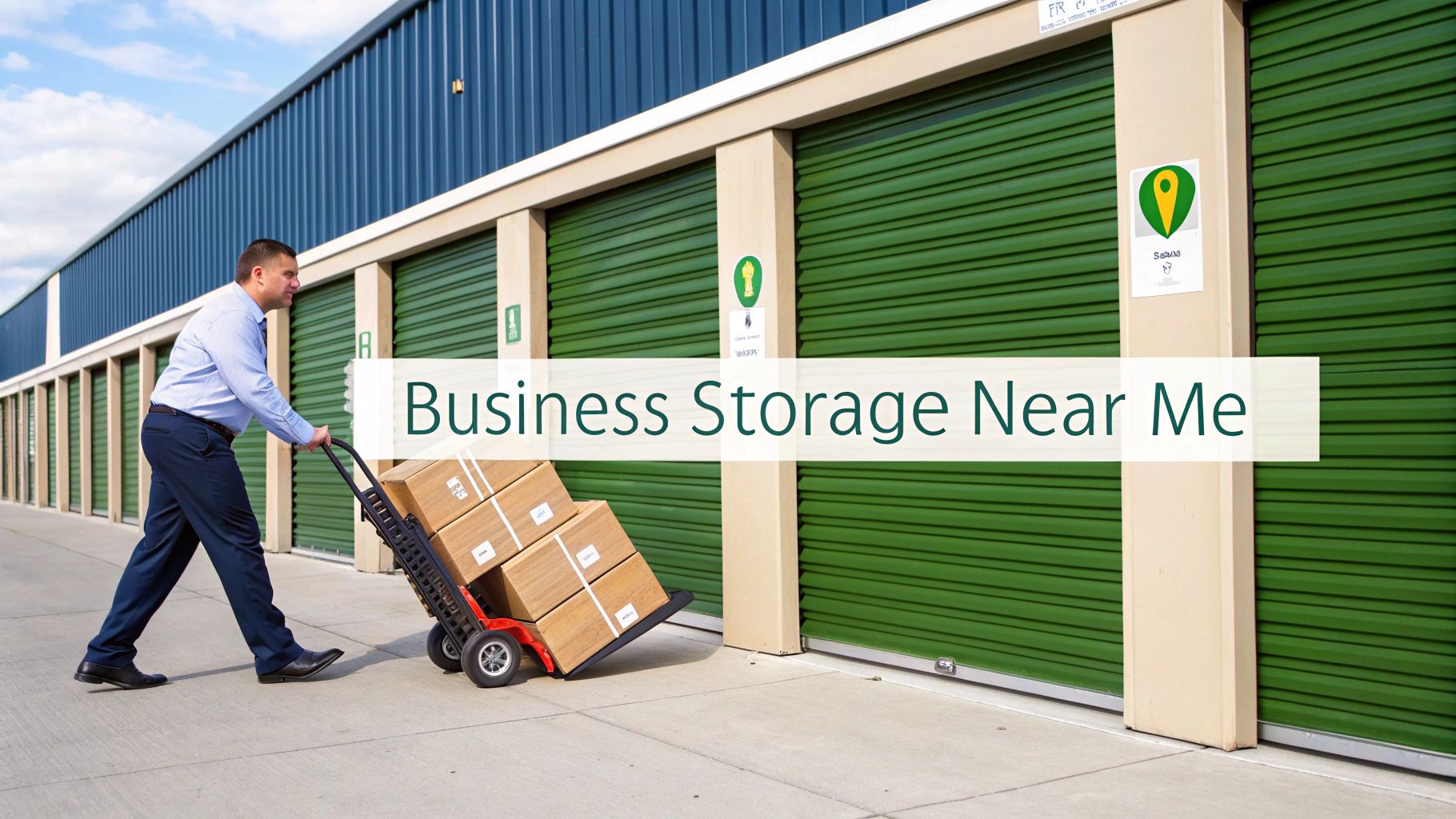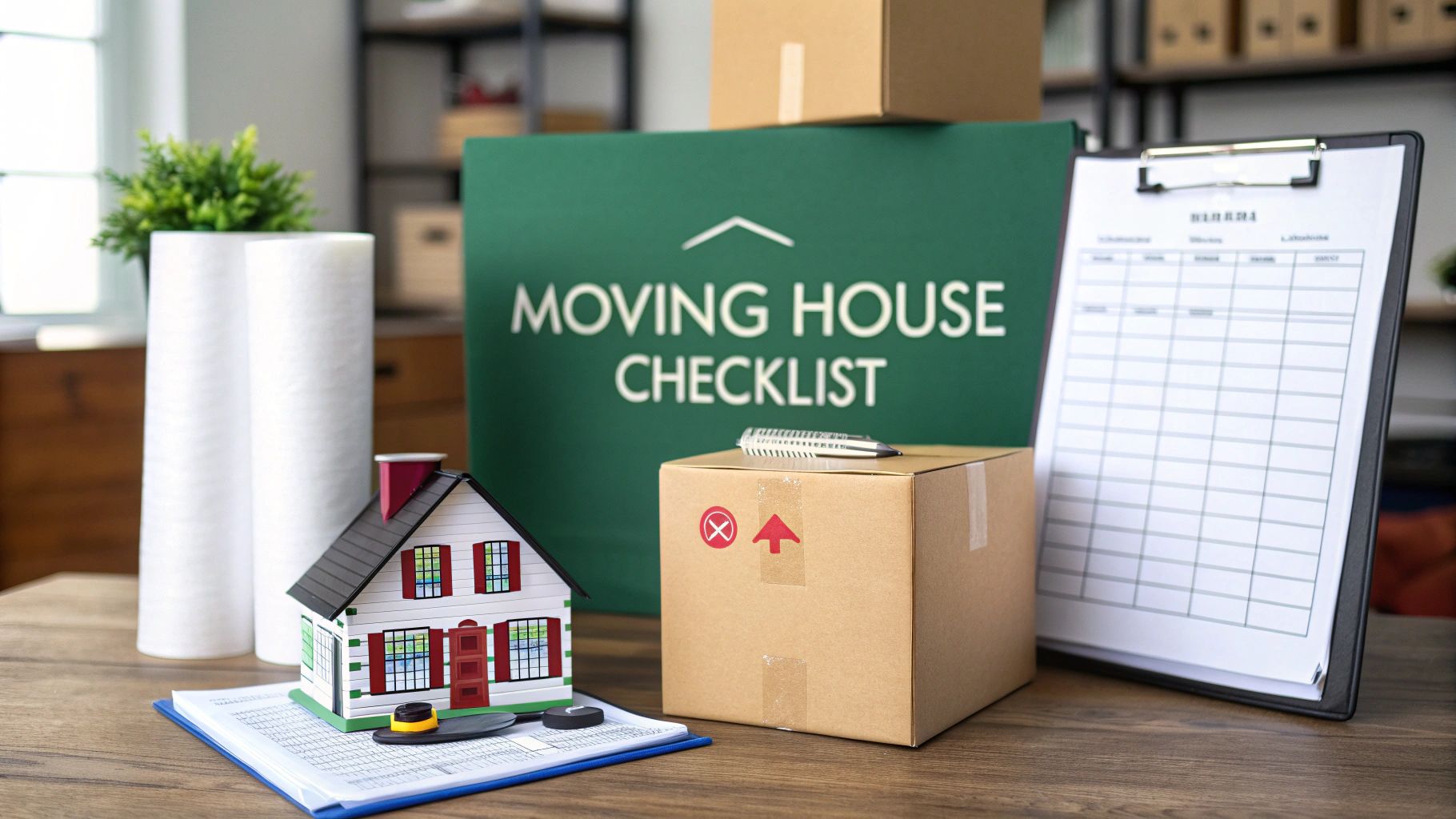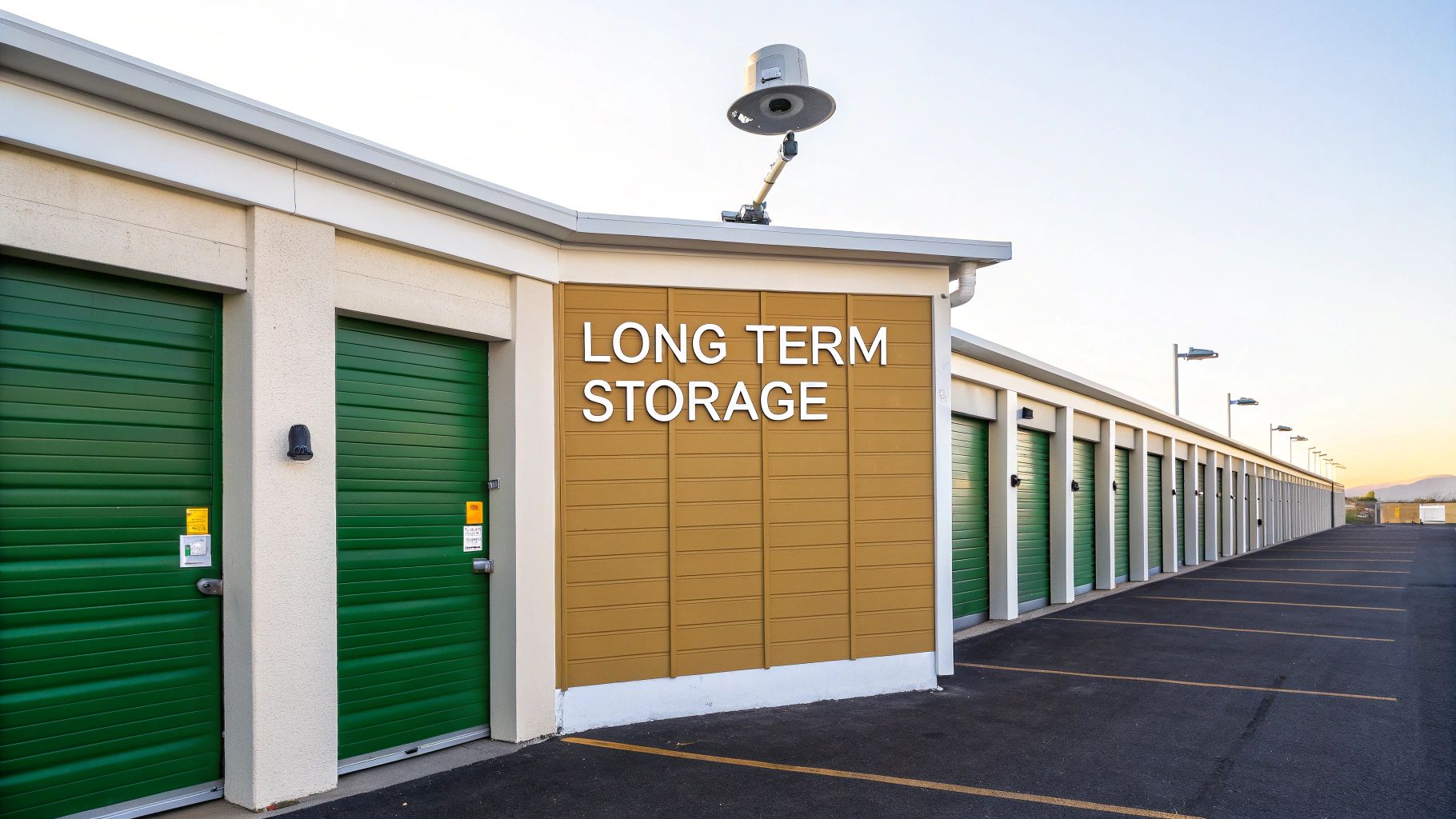How to Pack Your Storage Unit: A Step-by-Step Guide
Packing a storage unit properly can save you time, protect your belongings, and maximise space. Here’s a quick summary to get started:
- Plan Ahead: Sort items by usage, type, and fragility. Take photos and create a digital inventory.
- Choose the Right Unit: Pick a size that fits your needs and consider climate control for sensitive items.
- Use Proper Materials: Heavy-duty boxes, plastic bins, moisture absorbers, and padding like towels or bubble wrap.
- Pack Smart: Disassemble furniture, stack heavy items on the bottom, and wrap fragile items carefully.
- Organise for Easy Access: Use shelving, leave walkways, and label boxes clearly.
How to Pack a Storage Unit: Top Tips for Efficient Packing
1. Before You Pack: Getting Ready
Planning ahead can boost your storage efficiency by up to 30% and help protect your belongings from damage. Here’s how to get organised before you start loading your storage unit.
Make a Storage Plan
Start by sorting your items into three main categories:
- Access frequency: Place items you’ll need often (daily or weekly) near the front, and store seasonal or rarely used items toward the back.
- Item type: Group similar items together, like furniture or electronics.
- Fragility level: Keep delicate items separate from sturdier ones.
Take photos and make a digital inventory with detailed descriptions. For example: "Box 3A: Winter coats – Front-left shelf". This method makes it easier to find and track your belongings later.
Pick the Right Unit Size
Choosing the right unit size is key to avoiding unnecessary costs. Use this quick guide to help estimate your needs:
| Unit Size | Capacity | Common Uses |
|---|---|---|
| 5×5 (200 cu ft) | 10-15 medium boxes | Small apartment items |
| 10×10 (800 cu ft) | 1-2 bedroom contents | Furniture + 30-40 boxes |
| 10×15 (1200 cu ft) | 2-3 bedroom contents | Appliances + furniture |
Don’t forget to leave 18-24 inches of walkway space for easy access and to meet fire safety regulations. For items like electronics or wooden furniture that are sensitive to heat and humidity, consider renting a climate-controlled unit. This is especially important if temperatures exceed 80°F or humidity goes above 50%.
Get Your Packing Materials
Using the right materials can make all the difference. Stock up on these essentials:
- Heavy-duty boxes (30 lb capacity) for books and heavier items
- Plastic bins with gaskets to protect moisture-sensitive items
- Acid-free tissue paper for antiques or fragile items
- Clear plastic wrap to shield furniture
- Moisture absorbers to prevent humidity damage
For padding, repurpose towels or clothing, and rent moving blankets instead of buying them – this can save up to 40% on material costs.
To stay organised, try a color-coded labeling system. Label boxes on multiple sides with details like: KITCHEN – FRAGILE – Plates/Bowls (Box 2/5).
Once your items are sorted and your materials are ready, you’ll be set to pack efficiently and move on to the next step.
2. Packing Methods for Safety and Space
Take Apart Large Items
Once you’ve planned your storage layout (as covered in Section 1), the next step is to disassemble large furniture to make better use of your space. This can reduce storage space usage by up to 20%. Use simple tools like screwdrivers or Allen wrenches to remove legs from tables, sofas, or other bulky pieces. Collect all screws and small hardware in labeled ziplock bags, then tape them securely to the furniture they belong to.
For appliances, refer to the manufacturer’s manual for proper disassembly steps. To avoid injuries and protect nearby items, wrap sharp edges or corners with moving pads.
Pack Heavy to Light
Stacking items based on weight is key to maintaining stability and protecting your belongings. Follow this weight-based system:
| Layer | Items | Weight Limit | Placement Tips |
|---|---|---|---|
| Bottom | Books, Tools | 30 lbs per box | Place directly on the floor |
| Middle | Kitchenware | 25 lbs per box | Keep 18" away from walls |
| Top | Linens, Decor | 15 lbs per box | Stack no higher than 4-5 boxes |
Ensure the bottom layer accounts for about 60% of the total weight in your storage unit. Use a scale to confirm boxes stay under the 30 lb limit. If your stacks sway more than 2 inches when lightly pushed, redistribute the weight to improve stability.
Wrap Delicate Items
Proper wrapping is essential to avoid damage, which is often caused by poor packing (41% of the time, as noted earlier). For electronics, use anti-static wrap, add silica gel packets to prevent moisture, and remove all batteries to avoid corrosion.
For artwork and mirrors, pack them in picture boxes with cardboard corner protectors. Reinforce glass surfaces by applying X-shaped tape and covering them with moving blankets. Store these items upright in mirror boxes to minimise the risk of breakage.
When packing glassware, wrap each piece individually with acid-free paper. Then, group 3-4 items together using bubble wrap for extra cushioning. Once everything is wrapped, focus on organising the items to ensure they’re easy to access later.
3. Storage Unit Layout Tips
Once you’ve packed your items securely, the next step is organising them thoughtfully within your storage unit.
Plan Your Space
Start by mapping out your unit. Grab some graph paper and sketch the dimensions, dividing the space into zones based on how often you’ll need access to certain items.
Here’s a quick guide to setting up zones:
| Zone | Distance from Door | Items to Store |
|---|---|---|
| Front | 0-6 feet | Frequently used tools, seasonal items |
| Middle | 6-12 feet | Items you need monthly, like small appliances |
| Back | 12+ feet | Holiday decorations, archived paperwork |
Use Height Wisely
Make the most of vertical space with shelving that fits your unit’s size. For example, freestanding metal shelves work well in smaller 10×10 units, while industrial pallets are better for larger 15×20 spaces. If you’re using a climate-controlled unit, clear plastic shelves can help you easily spot and identify stored items.
Here’s how to organise items by height:
| Height Level | Best Items to Store |
|---|---|
| Floor Level | Heavy items like books, tools, or equipment |
| Middle Level | Medium-weight items like small appliances or boxes |
| Top Level | Lightweight items like linens, pillows, or decor |
Keep Paths Clear
To ensure easy access and safety, maintain wide paths. Primary aisles should be 24-30 inches, while secondary paths can be 12-18 inches. For a visual guide, mark these pathways on the floor with painter’s tape.
Here are a few tips to keep your unit organised and accessible:
- Stand mattresses along the aisles to act as protective barriers.
- Use the empty spaces inside appliances to store smaller boxes.
- Add wall hooks along pathways to hang tools or bikes.
sbb-itb-bb0686d
4. Storage Tips by Item Type
Use these tailored strategies to store specific items effectively and keep them in good condition.
Furniture Storage
Storing furniture properly depends on the material. For wooden furniture, clean it with wood-safe products and apply a wax or polish to prevent cracking or drying out.
For upholstered furniture, opt for breathable fabric covers instead of plastic wraps, as plastic can trap moisture and cause mildew. Place moisture absorbers in cushions and fabric folds to keep them fresh.
| Furniture Type | Preparation Steps | Storage Requirements |
|---|---|---|
| Wooden | Clean, polish | Climate control |
| Upholstered | Clean, cover, add absorbers | Breathable covers, avoid plastic |
| Mattresses | Use mattress bag, store upright | Rotate every 3-6 months |
Seasonal Items
Seasonal storage works best when items are well-contained. For example, store winter clothing in vacuum-sealed bags to save space. Wrap fragile holiday ornaments in acid-free tissue paper and place them in divided boxes for added protection.
For seasonal clothing:
- Add cedar blocks between layers to repel pests.
- Use clear, sealed bins for linens.
- Store delicate fabrics in cotton bags.
Tools and Equipment
Certain tools and equipment need extra care before storage:
Apply a light coat of machine oil to metal surfaces to prevent rust. For power tools, remove the batteries, use anti-moisture bags, and store them in a climate-controlled space.
Organise your tools efficiently with pegboards (holding 15-20 tools per board) or use hanging gutter systems for garden tools. For gas-powered equipment, empty the fuel and use a stabiliser before storing.
| Tool Category | Storage Solution | Maintenance Requirement |
|---|---|---|
| Hand Tools | Pegboard with hooks | Apply oil coating |
| Power Tools | Anti-moisture bags | Remove batteries |
| Garden Tools | Hanging systems | Clean thoroughly |
5. Keep Your Unit Safe and Clean
Maintaining a clean and secure storage unit is key to protecting your items and keeping everything in order.
Manage Temperature and Humidity
Keeping the right temperature and humidity levels is essential to prevent damage to your belongings. Aim for a temperature range of 55-80°F to protect fragile items and avoid warping, and keep humidity between 30-50%. Here’s how you can manage these conditions effectively:
- Place moisture absorbers near wooden furniture and electronics.
- Store documents and fabrics in airtight plastic containers with desiccant packs.
- Use a battery-powered humidity monitor to keep track of moisture levels.
Inspect Your Unit Regularly
Set up a routine to inspect your unit for any signs of trouble. Experts suggest checking your unit every two months at a minimum. Here’s what to look for:
- Moisture: Check for stains or damp spots every two months.
- Containers: Ensure seals are intact on a monthly basis.
- Climate: Review humidity and temperature readings monthly.
- Pests: Look for droppings or signs of pests every two months.
- Security: Test locks and other security measures monthly.
Strengthen Security
Pair your organised layout with strong security measures. Start by using a durable cylinder lock made of drill-resistant steel (at least 14-gauge). Additional security features to consider include:
- 24/7 digital surveillance with 90-day video storage.
- Motion-activated lighting for better visibility.
- Individual alarms for each unit.
- Secure access systems with unique PIN codes.
For added protection, consider insurance for valuable items. You can opt for replacement-cost coverage for high-value items like electronics or instruments.
Finally, seal any floor gaps with door sweeps to keep pests out. These small steps can make a big difference in keeping your items safe and easy to access.
Summary
By applying the planning, packing, and upkeep tips outlined earlier, you can create a well-organised and secure storage setup:
Strategic Planning and Preparation
Start by selecting durable containers – sturdy boxes that can hold up to 50 pounds and plastic bins for items prone to moisture damage. Allocate space for clear access paths to make navigation easier.
Space Optimisation and Protection
Make the most of your storage area with vertical solutions. Ensure proper airflow and take steps to prevent moisture, which is critical to keeping your belongings in good condition.
Organisation for Accessibility
Design your layout with 2-3 foot wide center aisles. Place items you use often near the entrance and reserve 20% of the floor space for pathways. Stick to uniform box sizes for safer, more stable stacking.
Long-term Protection Measures
Use specific protection methods for different types of items to keep them safe over time:
| Item Type | Protection Method |
|---|---|
| Electronics | Silica gel packs |
| Textiles | Climate control |
| Documents | Airtight containers |
| Furniture | Elevated storage |
Security and Maintenance
Regularly inspect your storage area and follow the security guidelines discussed in Section 5 to ensure everything stays safe.
FAQs
How to properly organise a storage unit?
To keep your storage unit organised over time, build on the packing strategies discussed earlier. A good system combines smart use of space with easy access to your items.
Use Vertical Space and Keep Pathways Clear
Maximise storage by installing wall-mounted shelving along the perimeter walls. This setup makes the most of vertical space while ensuring proper airflow and leaving clear pathways for access.
Layer Items for Protection and Easy Access
Follow a layered approach when arranging your items:
- Place heavy-duty boxes on the bottom shelves for stability.
- Store medium-weight items at waist level for convenience.
- Use the top shelves for lightweight containers to avoid accidents.
Label Everything Clearly
Take your labeling system to the next level. Use waterproof labels that include:
- The category, like "Kitchen" or "Bedroom."
- Specific contents, such as "Winter Coats: 5 jackets, 3 sweaters."
- Any warnings, like "Fragile."
Attach labels to two adjacent sides of each box so you can identify them easily, even when stacked. For added organisation, use a digital tracker that matches your Section 1 inventory system.








